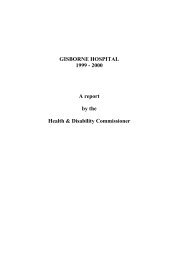09HDC01565 - Health and Disability Commissioner
09HDC01565 - Health and Disability Commissioner
09HDC01565 - Health and Disability Commissioner
Create successful ePaper yourself
Turn your PDF publications into a flip-book with our unique Google optimized e-Paper software.
<strong>Health</strong> <strong>and</strong> <strong>Disability</strong> <strong>Commissioner</strong><br />
RN Ms J<br />
171. RN Ms J notes she has previously acknowledged that she should have recorded Mr<br />
A‘s respiratory rate each time it was taken. She states she has reflected on her practice<br />
<strong>and</strong> now ensures respiratory rate is recorded each <strong>and</strong> every time she assesses a<br />
patient‘s vital signs. She suggests changing the neurological observation chart to<br />
include a space for recording the respiratory rate, to ensure that it is recorded by all<br />
nursing staff at all times.<br />
172. RN Ms J states she did not change the default settings on the bedside monitor.<br />
173. RN Ms J accepts that there were inaccuracies in her documentation of oxygen<br />
administration, again notes that this was a genuine mistake, <strong>and</strong> states that she now rechecks<br />
oxygen settings before documenting these.<br />
RN Ms K<br />
174. RN Ms K‘s legal counsel, Mr P, submits that ―the criticisms of RN [Ms K] are<br />
unreasonable <strong>and</strong> unjustified, particularly in regard to the fact that they are not put<br />
into context‖. He states that the criticism of RN Ms K seems disproportionate, given<br />
the indications that Mr A had died some time prior to the commencement of RN Ms<br />
K‘s shift.<br />
175. Mr P also states that it is difficult to comprehend how RN Ms K‘s care could be<br />
deemed suboptimal, when the delay in her seeing Mr A occurred because she was<br />
attending to a patient in pain.<br />
176. Mr P notes that RN Ms K had been given no cause for concern about Mr A at<br />
h<strong>and</strong>over, <strong>and</strong> she was reasonably entitled to expect that he was connected to the<br />
oxygen saturation monitor, which is st<strong>and</strong>ard practice, given the surgery that had been<br />
performed. Furthermore, RN Ms J had stated at h<strong>and</strong>over that Mr A‘s saturations had<br />
been fine during the previous shift. 34<br />
Opinion: Introduction<br />
177. Mr A was a fit <strong>and</strong> active 21-year-old. In late 2008, he was diagnosed with a Chiari<br />
malformation, a condition that prevented him from doing physical work. He reduced<br />
his physical activity <strong>and</strong> the symptoms improved. However, Mr A was keen to resume<br />
a more active life <strong>and</strong> return to work. He decided to proceed with surgery. The<br />
operation was performed, <strong>and</strong> Mr A‘s death less than 24 hours following surgery was<br />
wholly unexpected.<br />
178. The exact cause of Mr A‘s death has not been confirmed. The post-mortem report<br />
refers to the possibility of a ―functional loss of breathing control while asleep‖, <strong>and</strong><br />
34 As noted in paragraph 86, RN Ms K recalls being told that Mr A‘s vital signs were stable. Neither<br />
RN Ms J nor RN Ms K advised HDC that the h<strong>and</strong>over information included specific reference to Mr<br />
A‘s oxygen saturations.<br />
5 September 2012 30<br />
Names have been removed (except Canterbury DHB <strong>and</strong> the experts who advised on this case) to<br />
protect privacy. Identifying letters are assigned in alphabetical order <strong>and</strong> bear no relationship to the<br />
person’s actual name.
















